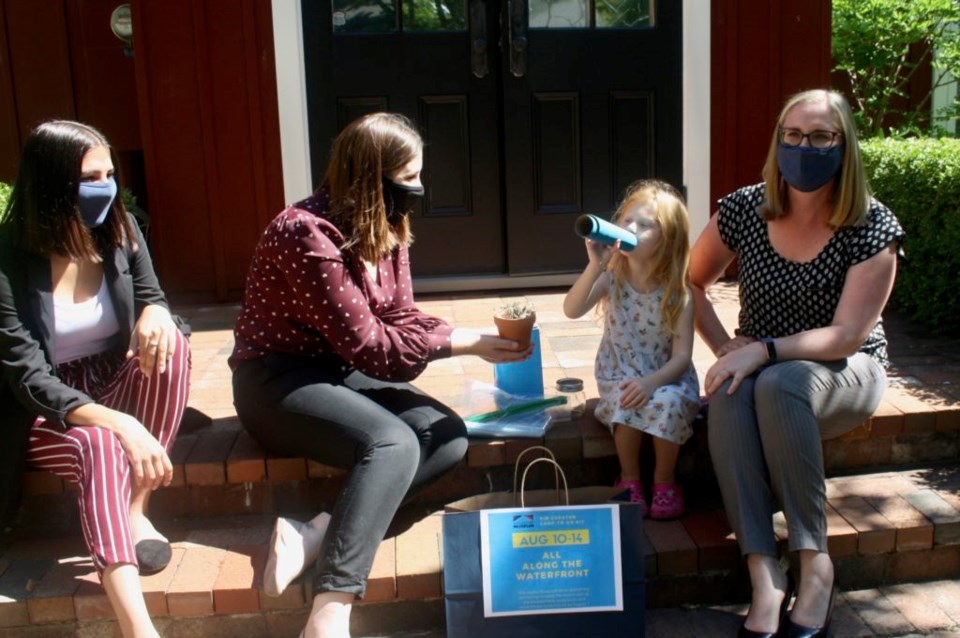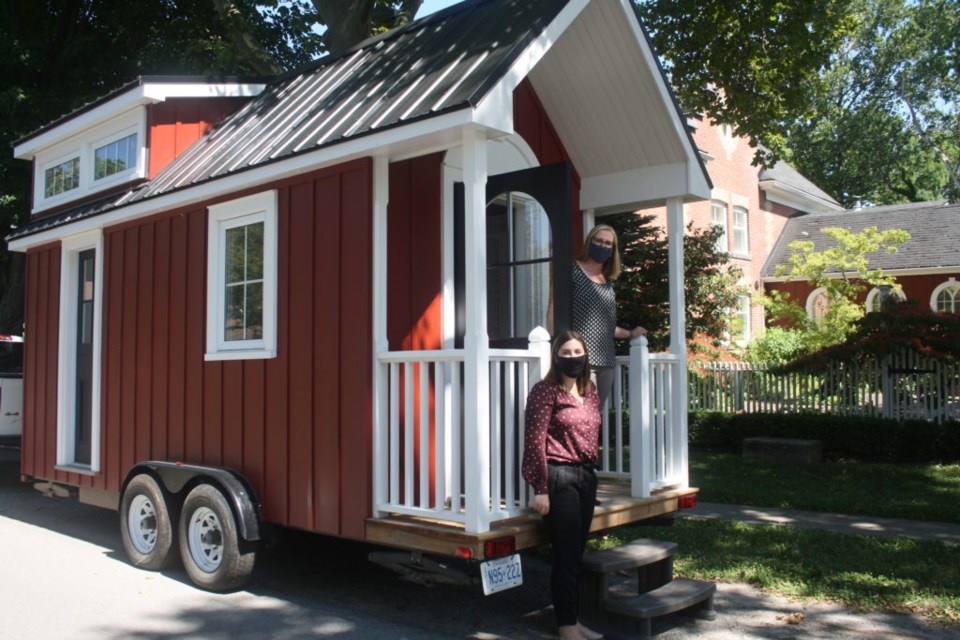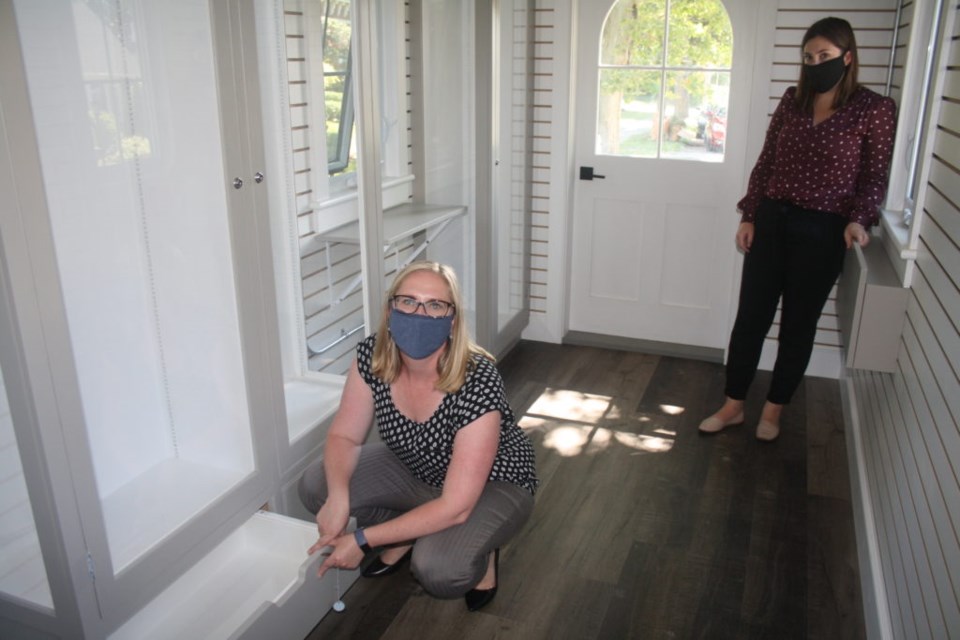
(Photos by Penny Coles)
Despite a pandemic that has cancelled most live events, the Niagara-on-the-Lake Museum is having a busy summer, keeping the public engaged, while moving toward an exciting future.
This is a museum with staff and board members determined to rebrand, expand and redesign space for programming and exhibits.
They won’t stand still, and if there is a perception of museums as dusty old spaces, that’s not this museum, says Sarah Kaufman, curator and managing director. It’s a small space, for now at least, with a lot going on, including high-quality exhibitions, programs, lectures, and more to come.
At the moment, next on their agenda is an at-home, day camp with crafts and activities to keep kids happy and busy while they learn about the history of their community.
The Niagara-on-the-Lake Museum is offering free kits for its Kid Curator summer camps during the month of August. Each week has a specific theme, and kits will be provided with crafts and activities for that theme.
Although the kits are free, Kaufman says the museum is asking parents to consider a donation of $25 to help cover the cost of materials.
Each kit needs to be ordered the Friday before the camp, and picked up on the Sunday or Monday of that camp week.
Shawna Butts, assistant curator and educational programmer has been working with program assistant Emma Facca, a Brock university student working for the summer at the museum, to develop curator camp themes that will keep youngsters interested. Some of the themes have been taken from past camps, and some are new, says Butts.
Next week, the camp begins with All Along the Waterfront, a topic that is important in NOTL, especially recently, says Butts.
“Each craft will come with instructions,” says Kaufman, who with her own youngsters at home, knows how important it is to keep them occupied. “We show them how to do the activity, and what the end result should look like. They should be able to do that with minimum adult supervision. The kits should be great for parents who need to work at home, and have their kids working alongside them.”
The activities are aimed at kids ages six to 10.
The museum is now open to the public, and has resumed walking tours, but until recently, was focused on keeping the public engaged through virtual programing.
A popular lecture series has been successful in the transition, says Kaufman.
Like many other organizations, the museum had plans to further develop online resources, but with COVID came a push to move forward more quickly than anticipated.
“Everyone is working hard to continue to be engaged with the public, to have a place in the community,” says Kaufman.
It has turned out to be helpful for community members who aren’t comfortable going out, and for reaching people through different formats.
“This has created a whole other level of awareness. I think our presence on social media, which we were more or less pushed into with COVID, really helped getting our name out there.”
It also came along at a time when they were already in the process of rebranding the museum, says Kaufman, chief of which was the new name for the former Niagara Historical Museum. “The Niagara-on-the-Lake Museum is more fitting, because we are the community museum. We’ve always seen ourselves that way.”
Next on their agenda is to put programming together and prepare to take the Tiny Museum on the road.
The museum recently received $37,800 from the Ontario Trillium Foundation’s Seed Grant and $25,000 from the David S. Howes Fund and Vintage Hotels NOTL Community Fund at the Niagara Community Foundation. The funds will be used towards the creation of exhibitions and education programs for their mobile museum. It sits on a trailer, parked beside the museum, with a truck ready to be loaded up with artifacts to take out into the community.
The hope is to be able to take it to schools, festivals and local events as they start up again, says Kaufman.
Each time it goes out into the community, the exhibits that travel with it can be tailored to the event and the community, she explains, such as Canada Day, the Peach Festival, The Landscape of Nations, the Virgil Stampede, or even a business event. “There are so many options for community exhibits,” she says.
School programs can also be adapted to supplement curriculums, says Kaufman, who is excited to think of all the outreach possibilities and opportunities for the Tiny Museum to take history out to the community.
Also exciting to contemplate is the coming expansion to the building, which has not seen a major renovation since the 1970s.
Kaufman says the expansion plans have not changed, nor has their budget, but once it’s time to start construction, it may have to be modified.
Currently all public programs must be held within the museum’s galleries, or outside the courtyard, due to a lack of proper programming space. That will change with the expanded space.
Also propelling the project is the need to accommodate the Accessibility for Ontarians with Disabilities Act, by 2025.
The expansion is expected to cost about $8 million, with a $2 million fundraising campaign that was put on hold due to the pandemic.
Kaufman says she doesn’t know yet whether the pandemic will also affect construction costs, and won’t until they are closer to the start of the project. “There’s so much we can’t determine, but we’re still moving forward with our budget and our plans. We are essentially shovel-ready.”
In the meantime, they’ve been working on the permits they need from the Town, so they can begin the next step, the procurement process.
And a lot of work ahead. With the major construction project they’re facing, Kaufman says, the museum will be closed and all the artifacts will have to be safely stored safely off-site during that time.
“We’ll have to do a lot of packing away at the museum, and we have to find a remote location to work from,” she says.
They’ve been putting feelers out and doing some research on the safest location for a year or two.
The site they choose will have to be climate controlled, or if not, can be adapted, she says. They’d also like to have staff there with the collection, and maybe be able to offer some research resources to the public.
The biggest question mark remains the infrastructure grant they are anticipating, which would fund about 75 per cent of the project. They expected news “this summer,” Kaufman says. Now they’re looking at the end of the summer to hear about that very significant source of funding.
If the major grant does not come through as expected, there are other avenues of grants they can search, she says.
One way or another, “this expansion is going to happen, and we’re itching to go. There is a lot in the works.”
For more information on the museum and its special events and exhibitions, visit www.niagarahistorical.museum or call 905-468-3912. The museum is located at 43 Castlereagh Street.




